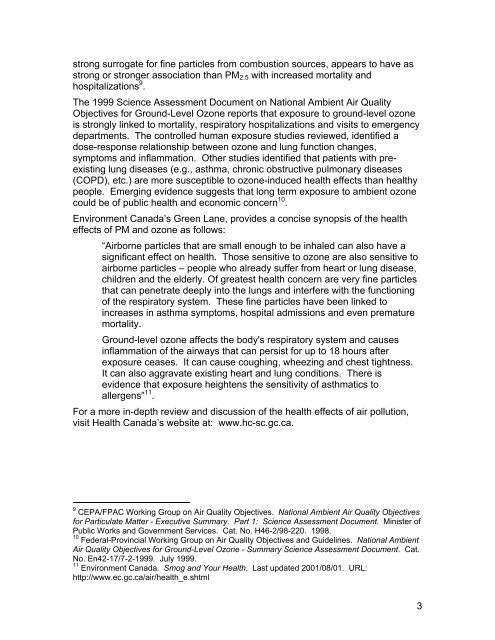(MERAF) for the Base Metals Smelting Sector - CCME
(MERAF) for the Base Metals Smelting Sector - CCME
(MERAF) for the Base Metals Smelting Sector - CCME
You also want an ePaper? Increase the reach of your titles
YUMPU automatically turns print PDFs into web optimized ePapers that Google loves.
strong surrogate <strong>for</strong> fine particles from combustion sources, appears to have as<br />
strong or stronger association than PM 2.5 with increased mortality and<br />
hospitalizations 9 .<br />
The 1999 Science Assessment Document on National Ambient Air Quality<br />
Objectives <strong>for</strong> Ground-Level Ozone reports that exposure to ground-level ozone<br />
is strongly linked to mortality, respiratory hospitalizations and visits to emergency<br />
departments. The controlled human exposure studies reviewed, identified a<br />
dose-response relationship between ozone and lung function changes,<br />
symptoms and inflammation. O<strong>the</strong>r studies identified that patients with preexisting<br />
lung diseases (e.g., asthma, chronic obstructive pulmonary diseases<br />
(COPD), etc.) are more susceptible to ozone-induced health effects than healthy<br />
people. Emerging evidence suggests that long term exposure to ambient ozone<br />
could be of public health and economic concern 10 .<br />
Environment Canada’s Green Lane, provides a concise synopsis of <strong>the</strong> health<br />
effects of PM and ozone as follows:<br />
“Airborne particles that are small enough to be inhaled can also have a<br />
significant effect on health. Those sensitive to ozone are also sensitive to<br />
airborne particles – people who already suffer from heart or lung disease,<br />
children and <strong>the</strong> elderly. Of greatest health concern are very fine particles<br />
that can penetrate deeply into <strong>the</strong> lungs and interfere with <strong>the</strong> functioning<br />
of <strong>the</strong> respiratory system. These fine particles have been linked to<br />
increases in asthma symptoms, hospital admissions and even premature<br />
mortality.<br />
Ground-level ozone affects <strong>the</strong> body's respiratory system and causes<br />
inflammation of <strong>the</strong> airways that can persist <strong>for</strong> up to 18 hours after<br />
exposure ceases. It can cause coughing, wheezing and chest tightness.<br />
It can also aggravate existing heart and lung conditions. There is<br />
evidence that exposure heightens <strong>the</strong> sensitivity of asthmatics to<br />
allergens” 11 .<br />
For a more in-depth review and discussion of <strong>the</strong> health effects of air pollution,<br />
visit Health Canada’s website at: www.hc-sc.gc.ca.<br />
9 CEPA/FPAC Working Group on Air Quality Objectives. National Ambient Air Quality Objectives<br />
<strong>for</strong> Particulate Matter - Executive Summary. Part 1: Science Assessment Document. Minister of<br />
Public Works and Government Services. Cat. No. H46-2/98-220. 1998.<br />
10 Federal-Provincial Working Group on Air Quality Objectives and Guidelines. National Ambient<br />
Air Quality Objectives <strong>for</strong> Ground-Level Ozone - Summary Science Assessment Document. Cat.<br />
No. En42-17/7-2-1999. July 1999.<br />
11 Environment Canada. Smog and Your Health. Last updated 2001/08/01. URL:<br />
http://www.ec.gc.ca/air/health_e.shtml<br />
3
















